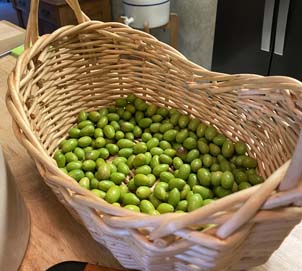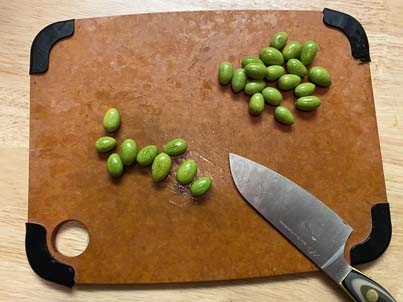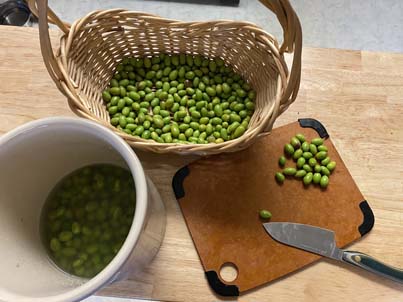Early December is olive season at the Tom Eddy Winery. Remnants of an olive grove planted long ago still dot the east side of the property. And like apples, our olive trees tend to produce well every other year. The year 2017 was a prolific one for olives but also the year of the Tubbs Fire which meant a lot of inedible fruit due to the heat and smoke. So fast forward to 2020, an off year to be sure except for one tree at the entrance to the ranch that grew hog wild and produced masses of small little green ‘football” shaped olives that I decided needed to be picked and cured. And cured is the operative word.
The first time I tried eating a fresh olive, was the last time. I was a freshman in college and it was late November. As I rode my bike to class I would pass under this long row of gorgeous olive trees with their long hanging grey green branches of black fruit. Olives fell everywhere along the bike path, black little masses whose seeds went zinging out to unsuspecting passer-byers as I rode over their fallen corpses. Why wasn’t anyone picking these, I wondered. And then I decided I had to try one to see what an olive tasted like that didn’t come from a jar.
I picked one and bit into it. Suddenly I felt the most horribly bitter attack on my tongue. Distasteful isn’t strong enough a word. I know now that it was the tannic acid that must first be leached out for it become that most delicious of morsels but I couldn’t get it out of my mouth fast enough. I laugh when I imagine what I must have looked like to a bystander.
So now I’ve got my memories and my basket of green olives. I could wait for them to turn black but the green ones are best for the method I’m going to use. I have several options for curing. The lye technique is the fastest and the most caustic. Not my style plus I hear there’s always a hint of lye in the end. So I have the brine, rock salt or fresh water methods. I chose the latter. More labor intensive and maybe even a longer curing period, but worth the effort and the wait.
First I sort through the olives taking out any that are bruised, pitted or damaged in any way. Then I take off any stem remnants and give them a quick rinse to rid them of any lingering dust. With a cutting board and a large flat knife, I gently crush each one to allow the bitterness to be released more quickly. (I could also make a slice in each one but they were much smaller than I’m used to so this seemed quicker).
After I’ve crushed them, I place them in either a tall quart glass containers or a ceramic crock pot which I have on hand and use just for this occasion. Then I fill the containers with water. If I see any olives float to the top, I place a zip lock bag half full of water on the water’s surface to keep the olives submerged. That’s it!
Every day (I try but sometimes I forget and a skip a day) I pour the olives into a colander, rinse them and the container, place them back in the container and fill it again with water. This goes on for several weeks, sometimes months. You’ll know when they’re ready because you can bite into one without spitting it out!
When they’re no longer bitter, I sauté them in batches of a warm marinade of olive oil, garlic, orange slice and a couple of squeezes of orange juice, and place them in jars. I add olive oil to the top to keep them fresh. I could process them in a hot bath as you would jams and jellies but I’m going to keep these in the fridge until they’re all gone, so I don’t need to do this extra step. They should keep for several months refrigerated.
I’ve been curing olives since 2008 and I’m always delighted to see the smiling faces of the people I get to share them with when they come for a tasting at our winery. Yep. Sometimes you get to taste more than just wine at Tom Eddy Winery!!



